Homemade Vodka Sauce
This post may contain affiliate links. Please read our disclosure policy.
This vodka sauce recipe makes it easy to simmer a batch of the popular creamy tomato sauce right at home. Goes with anything and ready in about 20 minutes!
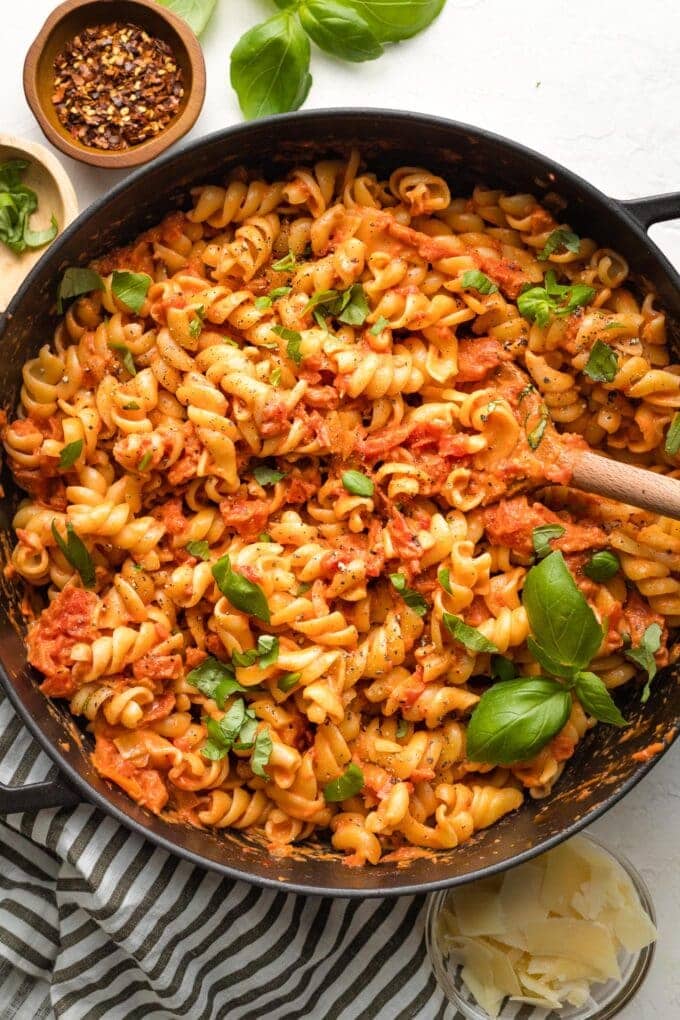
Vodka sauce. Maybe it’s something you order in a restaurant, or a jar you pick up off the shelf. With a bright flavor, creamy texture, and pretty pink-orange hue, vodka sauce is an incredibly popular way to dress up pasta and more.
Heads up: I’m going to hit you with a lot of information in this post, sort of like a homemade vodka sauce 101. This is the most comprehensive homemade vodka sauce recipe you will find! That said, you can definitely skip all the extra info and GO STRAIGHT TO THE RECIPE if you prefer!
While many prepared options are good, at the end of the day none can compare to homemade vodka sauce. The good news: this is not like a traditional bolognese or another sauce that is meant to simmer — and demand your attention — all day long.
You can make a truly luscious homemade vodka sauce in about 20 minutes. Just enough time to cook some pasta, throw together a salad, and call your (very fortunate) family members to the table for one delicious dinner.
What is Vodka Sauce?
The origins of vodka sauce are murky, to say the least, but one thing seems clear — it’s at least as American as it is Italian, and probably moreso. Penne alla vodka, the most traditional format, became enormously popular in the US during the late 1960s or early 70s. Some credit a chef, some credit the influential vodka industry. Either way, once the notion of a creamy tomato sauce laced with vodka caught on, it stuck.
Fundamentally, vodka sauce is a sauce made from tomatoes, cream, garlic, and onion. Vodka is the twist that might seem unexpected — it’s certainly not a traditional component of Italian cooking! But it adds so much.
Ingredients for Homemade Vodka Sauce
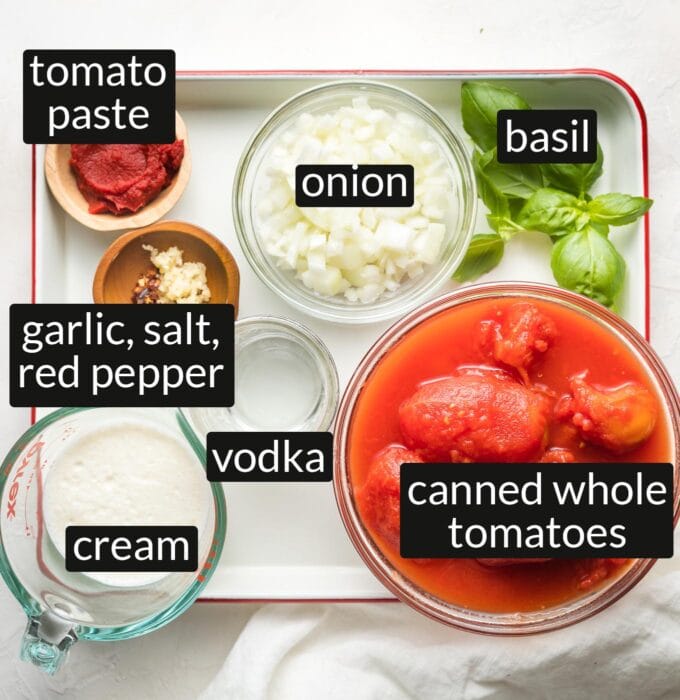
There are no extraneous ingredients here — as in so many classic recipes, the beauty lies in the simplicity. This means that quality matters. Each ingredient has a key part to play.
- Canned whole tomatoes. Whole peeled tomatoes occupy the upper tier of canned tomato products, quality-wise. They are usually packaged in either tomato juice or puree. Cans of crushed tomatoes can vary wildly in consistency and quality among brands, as you can read about more in this guide. In a recipe like this, where the tomatoes are front and center, it’s worth the small extra step of buying canned whole tomatoes and crushing them quickly by hand. San Marzano tomatoes are an especially high-quality variety, known for being excellent in sauces — worth the buy if you can.
- Tomato paste. Use just a smidge of tomato paste to thicken the sauce and enrich the flavor. It’s increasingly easy to find tomato paste sold in tubes, rather than cans, which is extremely helpful for reducing waste.
- Yellow onion. You’ll need just about 1/2 of a small yellow onion. You want a bit of the flavor without letting it overpower the tomatoes. You can chop the other half and freeze in a small zip-top bag; toss it straight from frozen into a skillet for any future meal that calls for diced onion.
- Garlic. Crucial flavor booster. Use fresh if at all possible!
- Cream. For the most creamy and luscious sauce, only genuine heavy cream will do. However, you can certainly make this with half and half in a pinch, or if you’re looking for an easy way to lighten things up a tad.
- Olive oil, table salt, red pepper flakes.
- And, of course… VODKA!
Ironically, vodka is one of the more controversial ingredients in vodka sauce. Many people ask…
Can I Make Vodka Sauce Without Vodka?
Technically, some say you can replace the vodka in vodka sauce with a bit of water and lemon juice. But in truth, it’s simply not vodka sauce without it.
So why add the alcohol? It’s like a true friend — it brings out the best in others! The harsh taste — and most of the actual alcohol — simmers away, but the residual vodka adds a subtle sharpness and unlocks the best flavors of the other ingredients, helping the tomatoes and cream form a harmonious marriage.
Cream sauces are delicious but finicky. They can separate easily, especially when cream is paired with an acid, such as lemon juice, vinegar, or… you guessed it, tomatoes. Vodka acts as an emulsifier, or binder, to marry the tomatoes and cream and ensure your sauce does not separate.
Vodka is also a solvent, which extracts and concentrates flavors without adding a competing flavor of its own. Water simply can’t do that!
So, go ahead and add the vodka. It will not get you or anyone else at the table drunk, and will make your sauce far more stable and delicious.
How To Make Vodka Sauce
- First, cook the onion and tomato paste together until the onion begins to soften. You can use either a saucepan or a high-sided skillet.
- Add garlic and red pepper flakes, and cook just briefly, until the garlic is fragrant.
- Now add the tomatoes. The best way to do this is using your hands, holding each tomato just above the skillet and squeezing it in your fist to crush it lightly. The juices and crushed bits will fall right in.
- Add vodka and let it bubble away. This is when the alcohol cooks off.
- Stir in the cream and let it warm through. Boom! Homemade vodka sauce!
It’s worth noting that in a previous version of this recipe, I suggested blitzing a portion of the tomatoes in a food processor or blender, and chopping the rest. That definitely yields a good result, but takes considerably more time and equipment.
The past four or five times I’ve made vodka sauce, I’ve used the hand-crushing method, and it’s the only way I’ll do it from now!
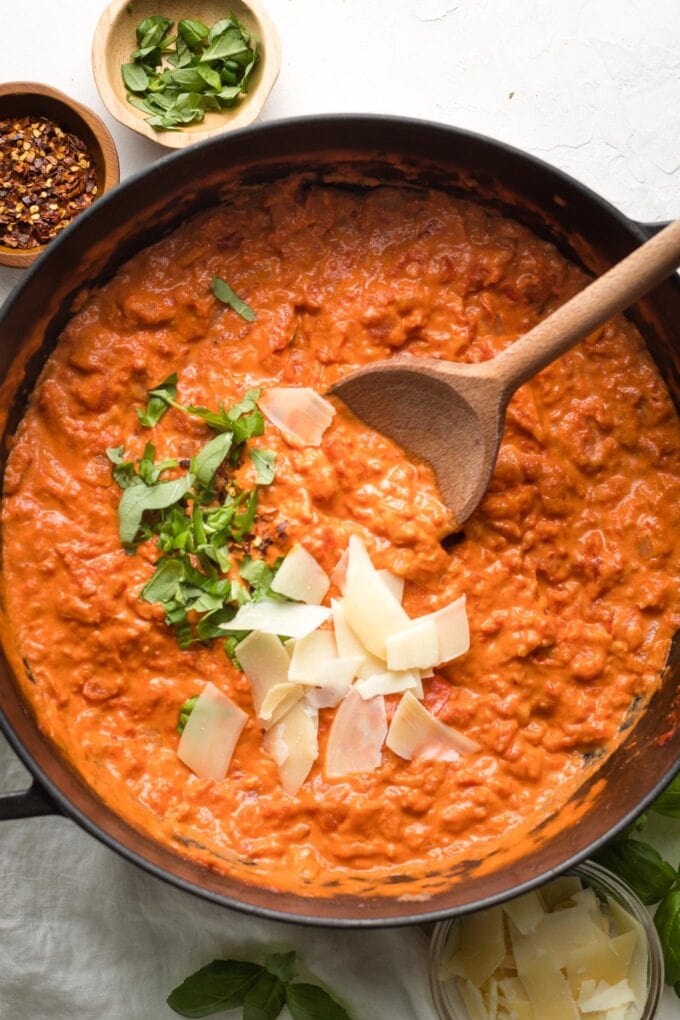
Ways To Serve Vodka Sauce
What will you do with your homemade vodka sauce? If you need inspiration, here are some ideas:
- Make a traditional penne alla vodka. Serve it plain — the sauce by itself contributes tons of flavor — or throw in any other meat or veggies you like. Chorizo, mushrooms, and sun-dried tomatoes are some of our favorite add-ins.
- Make gnocchi alla vodka or use any other pasta shape. Any shape with some ridges or twirls is a good choice. You want some nooks and crannies to hold the sauce.
- Swap vodka sauce into any recipe that calls for generic pasta sauce. It adds flavor and depth well beyond most varieties, yet is flexible enough to fit most recipes.
- Keep it low carb and pair with chicken or shrimp. Spoon vodka sauce over cooked chicken breasts, sprinkle with cheese or fresh herbs if desired, and serve. For seafood lovers, you can warm a bit of vodka sauce in a skillet, then saute shrimp straight in the sauce for great flavor and an easy meal!
- Make vodka sauce zucchini boats. Make a quick filling of vodka sauce, cheese, and any other veggies you like. Scrape out the insides of a few zucchini, fill with the mixture, and bake until the zucchini are tender.
More Frequently Asked Questions
Rotini, fusilli, cavatappi, and radiatori all have plenty of ridges and crevices perfect for holding this luscious sauce. Farfalle and penne are great options, as well.
Serve this pasta with an Italian salad and breadsticks, garlic bread (obviously), or some roasted broccolini or a simple arugula salad. The peppery arugula goes especially well with the natural bite of vodka sauce!
Vodka sauce keeps well in the fridge at least 4-5 days! Simply prepare the sauce fully, then rest on the counter long enough to cool all the way to room temperature. Transfer to an airtight container, store in the fridge, and use as you would any other jarred pasta sauce.
Yes! That’s another benefit of vodka sauce — many cream-based sauces fare poorly in the freezer, because of their tendency to separate, but the emulsification powers of vodka keep this sauce stable.
To freeze vodka sauce, allow it to cool completely to room temperature, then transfer it into freezer-safe containers or zip-top bags. Do not fill all the way to the top — some room for expansion is necessary. Sauce will keep well in the freezer for up to 6 months.
When you want to use the sauce, thaw it in the fridge overnight, then transfer it to a saucepan and warm over medium-low to low heat, stirring occasionally. Using higher heat may be tempting, but is likely to result in unpleasant splatters.
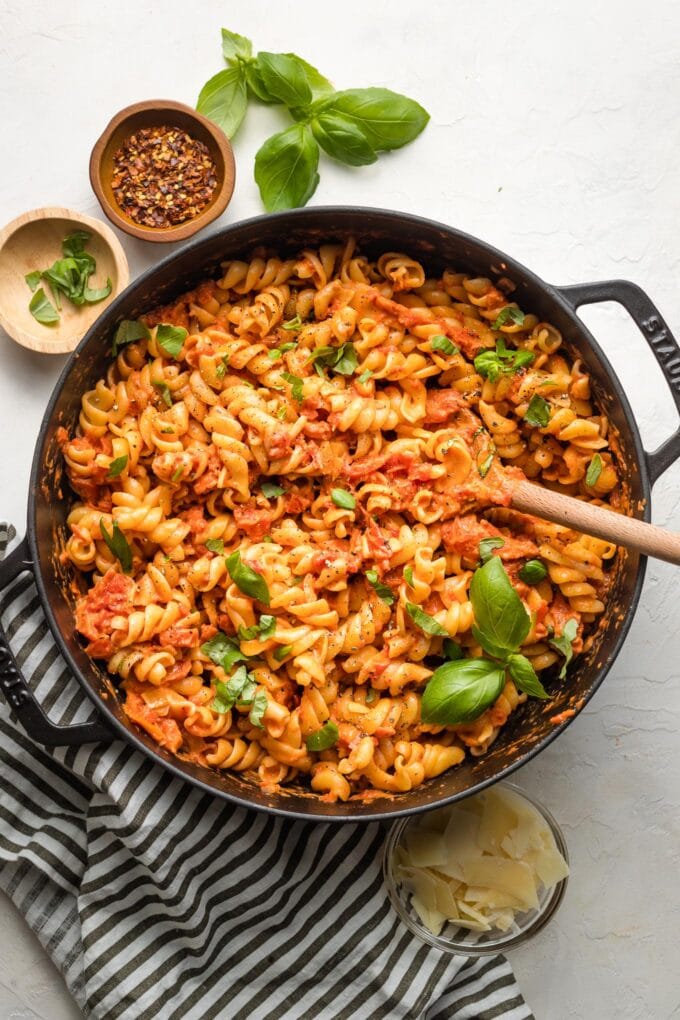
Helpful Equipment
- Medium saucepan — good or great — or a skillet as shown here
- Angled measuring cup
- Garlic press
Last but certainly not least, if you enjoy making this from scratch, you’ll also love homemade marinara and this perfect weeknight bolognese.
If you try this homemade vodka sauce, don’t forget to rate the recipe and leave a comment below. I love hearing how recipes turn out in your kitchen, and it helps other readers, too.
You can also FOLLOW me on PINTEREST, INSTAGRAM, and FACEBOOK for more great recipes and ideas!
Homemade Vodka Sauce
Ingredients
- 1 tablespoon olive oil
- 1/2 small yellow onion finely chopped
- 2 tablespoons tomato paste
- 2 cloves garlic minced
- 1/4 teaspoon red pepper flakes
- 1 can (28 ounces) whole peeled tomatoes
- 1/2 teaspoon table salt
- 1/4 to 1/3 cup vodka
- 1/2 cup heavy cream
Instructions
- In a large saucepan or high-sided skillet, warm olive oil over medium-high heat until it shimmers. Add onion and tomato paste. Cook for 2-3 minutes, stirring occasionally, until the onions begin to soften.
- Add garlic and red pepper flakes. Cook for 30-60 seconds, just until the garlic is fragrant.
- Use your hand to add the tomatoes, holding each one just above the skillet and squeezing it in your fist to crush it lightly, letting the juices and crushed bits fall into the skillet. Pour in remaining liquid from the can, and season with salt.
- Stir in the vodka, bring sauce to a simmer, and allow to bubble for 6-8 minutes, stirring occasionally. Reduce the heat if the bubbling becomes very vigorous.
- Stir in the cream and cook for 1-2 minutes, until heated through. Use as desired.
Video
Notes
- Consistency: As written, this recipe yields a sauce with medium consistency — smooth but with bits of tomato and onion speckled throughout. See photos in the post for a visual. If you prefer a smoother sauce, you have several options — 1.) blitz the finished sauce in a blender or food processor, 2.) blitz the tomatoes in a blender or food processor before adding to the sauce, 3.) use canned crushed tomatoes. Option 3 is the easiest but my least favorite, because crushed tomatoes vary widely in quality and are rarely as good as canned whole tomatoes.
- Storage: Prepare the sauce fully, then allow it to rest on the counter long enough to cool all the way to room temperature. Transfer to an airtight container and store in the fridge for 4-5 days.
- Freezing: Cool sauce completely to room temperature, then transfer it into freezer-safe containers or zip-top bags. Do not fill all the way to the top — leave some room for expansion. Freeze for up to 6 months. To thaw, place in the fridge overnight, then transfer sauce to a saucepan and warm over medium-low to low heat, stirring occasionally. Using higher heat may be tempting, but is likely to result in unpleasant splatters.
- Recipe Revision: It’s worth noting that in a previous version of this recipe, I suggested blitzing a portion of the tomatoes in a food processor or blender, and chopping the rest. That definitely yields a good result, but takes considerably more time and equipment. The hand-crushing method outlined above is much simpler and yields an almost indistinguishable sauce.
Nutrition Estimate
This post was originally published September 15, 2018, and has been updated with new photos, a simplified technique, answers to common questions, and more helpful tips.

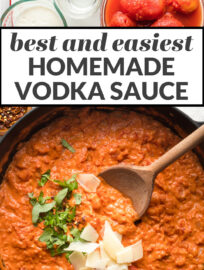
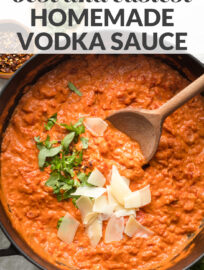
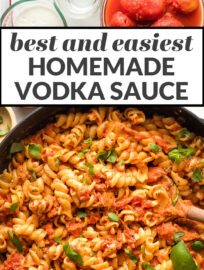
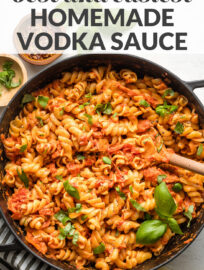
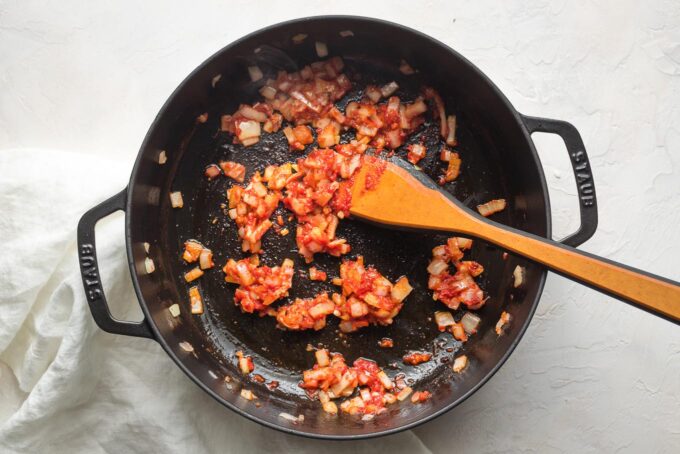
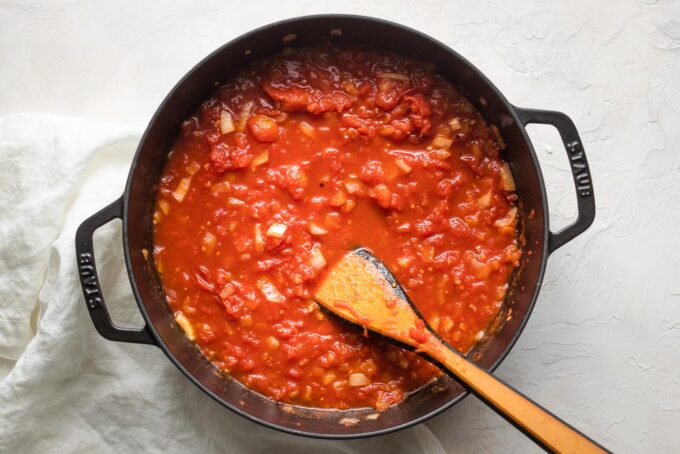
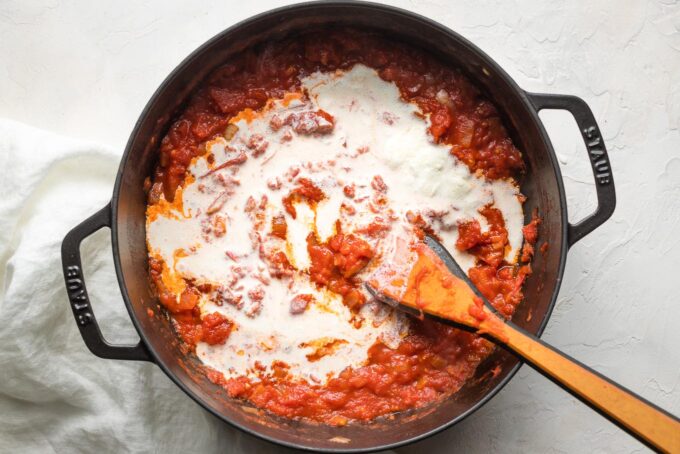
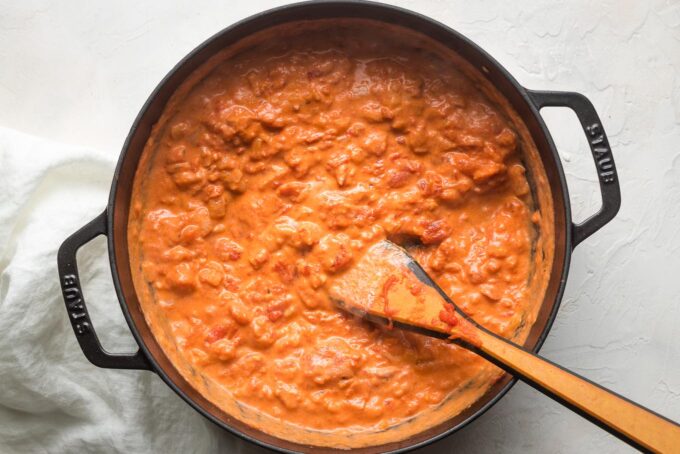
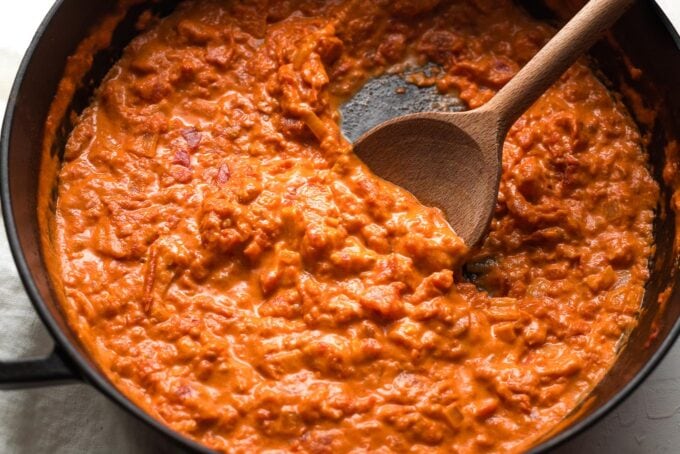

This had a terrific flavor. I sautéed some vegetables I had leftover (zucchini, carrots, mushroom and surprisingly Brussel sprouts) added some leftover chicken and finished with pasta. Yummy
So quick and easy! Can’t wait to do it again. We added sausage !
delicious, as always 🙂